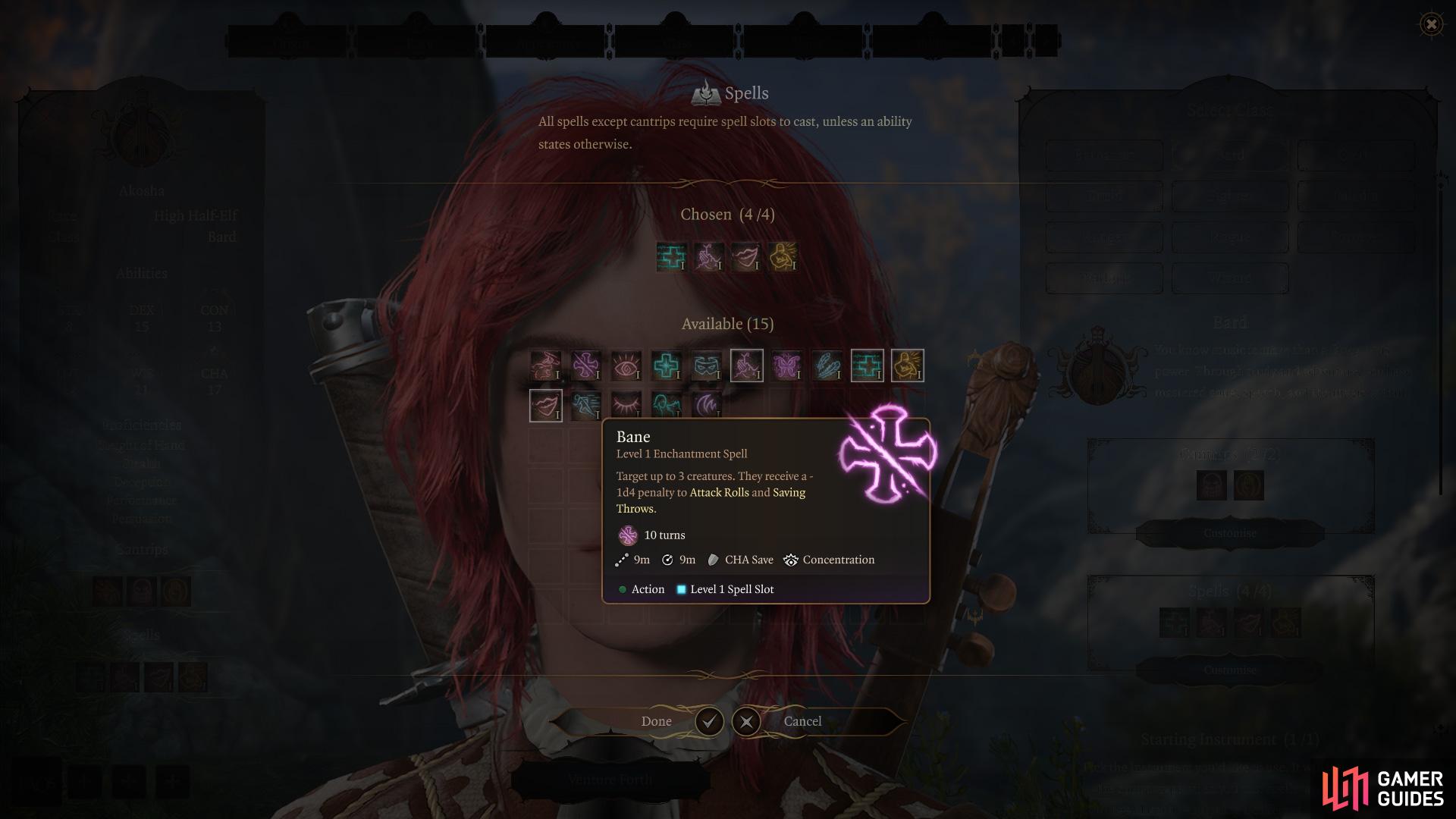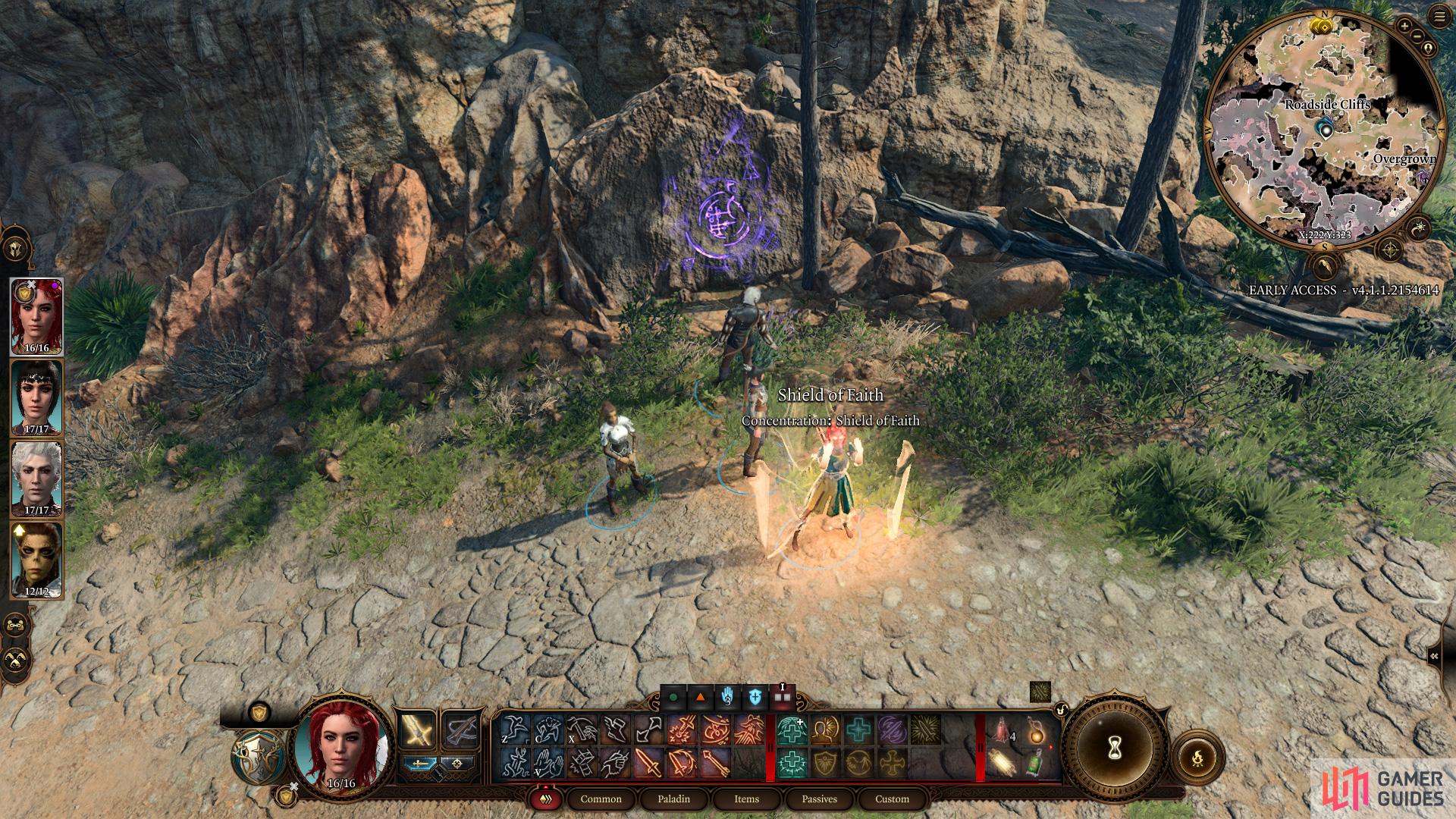Not all spells function the same in terms of gameplay in Baldur’s Gate 3 - some are simple fire-and-forget spells, but others, especially those with lingering effects, require the caster to maintain their focus for the spell’s duration. Some spells unerringly strike their targets, others must be aimed or even require the caster to land a hit in melee combat. Regardless of the spell’s delivery mechanism and range, most give their victims a chance to resist or nullify their effects. All these variables of spell combat will be discussed on this page.
A spell’s info box details its various parameters, including duration, range, radius, Saving Throw, whether it requires Concentration and its casting time.
Duration¶
It should be no surprise that the duration of spells in Baldur’s Gate 3 varies considerably. Often the first item listed under the spell’s description, a spell’s duration can range from instantaneous (the effects will be immediate - most healing or direct damage spells, for example - and in these cases, no duration will be specified), a specified number of turns (1 turn and 10 turns being common) or until the affected character takes a Long Rest, a nebulous window of time, to be sure, but functionally it means all day, unless countered.
Range and Radius¶
Represented by a dashed line connecting two dots (Range) and circle drawn by compass (radius) a spell’s range specifies how far away from the caster the target can be, and its radius, if applicable, indicates the area (or the characters within what area) will be affected. Some spells have both a range and a radius, others have one or the other. If a range isn’t specified, that spell is centered on (and in most cases, affects) the caster, if a radius isn’t specified, the spell only affects the selected target.
Spell ranges aren’t as complicated as they could be, typically coming in a half-dozen or so common variants: caster (spell affects, or is centered on the caster), melee (target must be in melee range), 3 meters, 5 meters, 9 meters or 18 meters. Radii are more varied, but less common. In the case of offensive spells with a radius effect, be wary of friendly fire!
(1 of 2) Most single-target, direct-damage dealing spells require the caster to succeed at an Attack Roll,
Most single-target, direct-damage dealing spells require the caster to succeed at an Attack Roll, (left), while debilitating and/or AoE spells do not require Attack Rolls, at the expense of permitting a Saving Throw. (right)
Attack Rolls and Saving Throws¶
Most single-target, ranged, damage-dealing spells require the caster to make an Attack Roll in order to hit the target, just like a mundane ranged or thrown attack. The caster has Proficiency with any spells they can cast, and they add their spellcasting classes’ Ability Score modifier (either Intelligence, Wisdom or Charisma, depending on the class) to the Attack Roll, otherwise checking the opponent’s Armor Class like any other attack.
Spells that debilitate instead of damage as well as spells with an area-of-effect radius typically do not require an Attack Roll, instead allowing the target(s) to attempt a Saving Throw. The difficulty of the spell’s Saving Throw is usually 8 + Proficiency + Caster’s Ability Score modifier, and the exact Saving Throw the target must pass varies depending on the spell cast: Bane requires a CHA Save, Burning Hands requires a DEX Save, Command requires a WIS Save.
Spells like Shield of Faith require the caster’s Concentration to remain in effect, precluding the casting of other spells with Concentration, lest the original spell be abandoned.
Concentration¶
Some spells aren’t looking for anything serious - you click the icon, select a target, and it’s done. Effects happen, dice rolls are made, much rejoicing and/or upset occurs. Classic. Some clingy spells - typically those with lingering effects - require more commitment from casters; these are spells that require Concentration. We won’t say it’s a 50/50 split between fire-and-forget spells and spells that require Concentration, but there’s plenty of both, and it can be important to diversify your arsenal with both types of spells, as once you cast a spell that requires Concentration, you cannot cast another spell that requires Concentration until the first has ended, otherwise you’ll abandon the first spell in favor of the second. Also, if you take damage while a spell that requires Concentration is active, you must make a CON Save (DC = 10, or half the damage sustained, whichever is higher). Certain debilitations, like sleeping caused by the Sleep spell, can also break Concentration.
While you’re Concentrating on a spell you can still move, attack, jump or even cast spells that don’t require Concentration! It can be useful to keep a mix of Concentration and fire-and-forget spells handy, lest Concentration spells bottleneck your offense.
Casting Time¶
Casting time used to be a more onerous and complicated feature of the older Baldur’s Gate games, and without going into detail here (see the trivia box, below, if you must suffer the musings of an olde tymey CRPG gamer), the casting times of spells has been greatly simplified for 5th Edition Dungeons and Dragons. Like most everything you do in combat, most spells take either a single Action, or a Bonus Action, and are cast instantaneously on your turn. No fuss, no muss. The vast majority of spells take normal Actions to perform, just like standard melee and ranged attacks, but a few, like Expeditious Retreat, Feather Fall, Healing Word and Shield of Faith only take Bonus Actions, allow them to be cast in a turn in which you also take a normal Action.





 Sign up
Sign up
No Comments